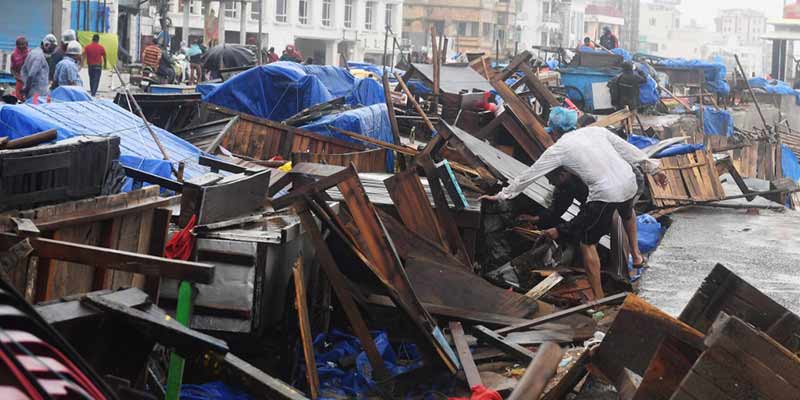- India
- May 04
How tropical cyclones get their names
When Cyclone Fani made landfall in Odisha on May 4, the name - which was suggested by Bangladesh - also evoked curiosity. India Meteorological Department (IMD) additional director general Mrityunjay Mohapatra said Fani, pronounced as ‘Foni’, means a snake’s hood.
Some names of previous cyclones were Hudhud, Ockhi, Titli and Gaja. Earlier, Mala, Helen, Nargis and Nilofer were names of lethal cyclones that have brought violent winds, heavy rains and wreaked destruction.
Tropical cyclones are named to provide easy communication between forecasters and the public regarding forecasts, watches and warnings. Since the storms can often last a week or longer and that more than one can be occurring in the same basin at the same time, names can reduce the confusion about what storm is being described.
Each tropical cyclone basin in the world has its own rotating list of names. For cyclones in the Bay of Bengal and Arabian Sea, the naming system was agreed by eight member countries of a group called World Meteorological Organisation/Economic and Social Commission for Asia and the Pacific (WMO/ESCAP) and took effect in 2004.
How are cyclones named?
The WMO/ESCAP panel on tropical cyclones, at its 27th session held in 2000 in Muscat, Oman, agreed to assign names to tropical cyclones in the Bay of Bengal and Arabian Sea. After long deliberations among the member countries, the naming of tropical cyclones over north Indian Ocean commenced from September 2004.
The eight countries along the Bay of Bengal and Arabian Sea - Bangladesh, India, Maldives, Myanmar, Oman, Pakistan, Sri Lanka and Thailand - suggest names that are sequentially listed. The nations suggest names alphabetically.
The Regional Specialised Meteorological Centre (RSMC) based in New Delhi gives a tropical cyclone an identification from the names list. The identification system covers both the Arabian Sea and the Bay of Bengal.
So, for instance, Bangladesh suggested ‘Onil’ the first in the list. Onil originated in Arabian Sea, off the Gujarat coast between September to October 2004. It made landfall in the state, but impacted both India and Pakistan.
Cyclone Phetai, suggested by Thailand, originated in the Bay of Bengal and made landfall in Andhra Pradesh, ravaging the coastal districts in December last year.
The next cyclone, whenever it originates, will be named ‘Vayu’, suggested by India.
Of the 64 names suggested by these eight countries, 57 have been utilised. After the 64 names are exhausted, the eight countries will propose a fresh list of names.
When did the naming start?
The first use of a proper name for a tropical cyclone was by an Australian forecaster early in the 20th century. He gave tropical cyclone names “after political figures whom he disliked”.
During World War II, tropical cyclones were informally given women’s names by US Army Air Corp and Navy meteorologists (after their girlfriends or wives) who were monitoring and forecasting tropical cyclones over the Pacific.
From 1950 to 1952, tropical cyclones of the North Atlantic Ocean were identified by the phonetic alphabet (Able-Baker-Charlie-etc.), but in 1953 the US Weather Bureau switched to women’s names. In 1979, the World Meteorological Organisation and the US National Weather Service (NWS) switched to a list of names that also included men’s names.
The Northwest Pacific basin tropical cyclones were given women’s names officially starting in 1945 and men’s names were included beginning in 1979. Beginning on January 1, 2000, tropical cyclones in the Northwest Pacific basin are being named from a new and very different list of names.
The North Indian Ocean region tropical cyclones are being named since October 2004.
Can the public suggest names?
According to a circular on naming cyclones over the North Indian Ocean, if the public wants to suggest the name to be included in the list, the proposed name must meet some fundamental criteria. “The name should be short and readily understood when broadcast. Further, the names must not be culturally sensitive and must not convey some unintended and potentially inflammatory meaning,” it said. The name can be communicated to the IMD director general.
Cyclones, hurricanes and typhoons
Storms over the South Pacific and Indian Ocean are known as cyclones. In the North Atlantic, central North Pacific, and eastern North Pacific, the term hurricane is used. The same type of disturbance in the Northwest Pacific is called a typhoon, according to the National Ocean Service of the US’ National Oceanic Atmospheric Administration.

